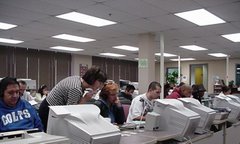The idea of using social networks in the classroom is still outside the ken of many classroom instructors. Sites such as Facebook , MySpace and Twitter have connotations that many instructors instinctively avoid. They see the pitfalls, but not the value. There are warning flags all over the place. I’ve heard educators say,’ if you allow students to use a site like Twitter in the classroom, students will abuse it and just network with friends’. Sure, always a possibility. But if you allow students Internet access on computers, they can always access sites you don’t want them accessing. It all comes down to the control an instructor has in the classroom. An ineffective instructor with no classroom discipline doesn’t need an access wire to fail. Those are the teachers who would let handwritten notes to be passed around the classroom in the pre-tech days.
We’ve (reluctantly) moved to acceptance of using academic websites in the classroom. Instructors see the value, and students know and like using them. We’ve found the value in YouTube , but have developed Teacher Tube to combat many of the content concerns. Social network sites are still a new frontier. First, instructors are not all that familiar with them. I think every instructor (and parent) should get on the computer and sign up for one or more of the social network sites, if only to know what it is that the kids are doing. One thing is certain, the KIDS are on them, daily, and even hourly. They can access them from classroom computers, or cell phone browsers. I have Facebook and Twitter buttons on my iPhone, so access takes less than a second. Of course they also let me know via email when someone has added something new to my page. It’s all about accessibility, and for kids, it’s like breathing. They just do it. My nephew once said that if he had to go more than a few hours without Facebook he would implode. I honestly believe him.
So how do educators use these tools? Tom Preskett in his article Blogs for Education, Blogs for Yourself mentioned the Write4 website ( http://write4.net/en), which allows one to publish articles, photos, videos etc. without set-ups or logins. Your work is published to your Twitter account. What’s the value? Easy and fast access. You give your students one site (such as your classroom Twitter account), and give them the ability to access these sites wherever and whenever they wish. You simply tell them to follow your Twitter, and they access your Tweets. It’s simple, and effective, because students are there anyway. Will all students actually read your Tweets? No, but not all students will read the homework you assign, or even participate in class discussions. But the point is that students are familiar with social networking, and use it regularly. And as educators, we have to believe that most students want to learn, and want to succeed.
I’ve never been able to understand instructors who believe students want to fail. They may not hang on your every word, but they do listen and know the correlation between work and success. Give them something they can use, and they will pay attention. Will they push the envelope? Of course. But that happens with any age group. Case in point: professional development programs. Put a group of instructors into professional development class and watch them as they stare out the window, play with anything but the prescribed websites on the computer, and even talk and laugh with each other. In a training setting, most professional educators mirror the behavior of their students. The key to success is the same as the key needed to succeed with students: give them something they find useful.
Subscribe to:
Post Comments (Atom)


No comments:
Post a Comment